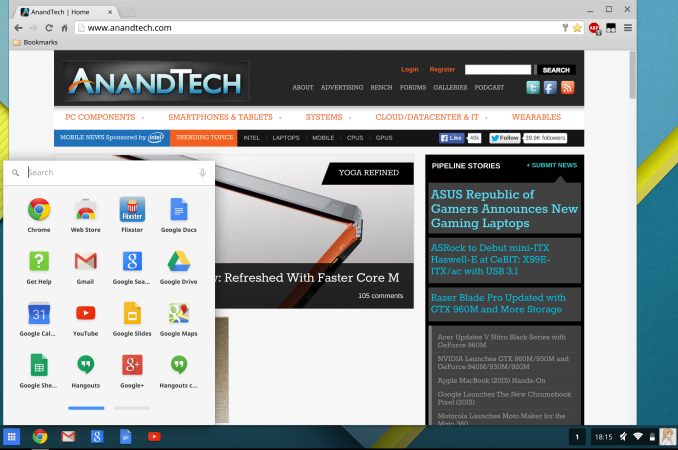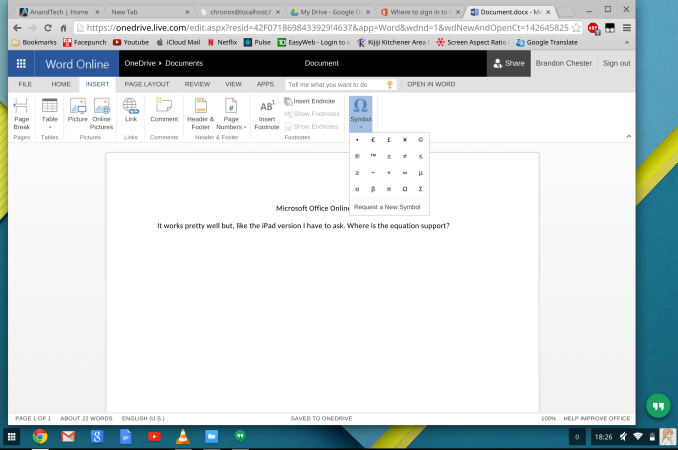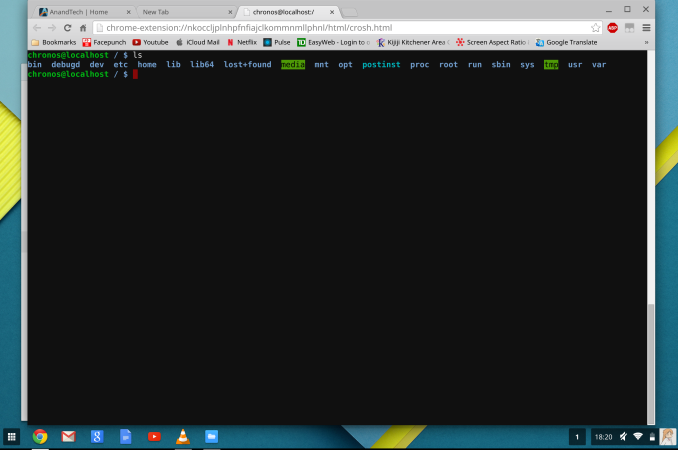The Chromebook Pixel (2015) Review
by Brandon Chester on March 16, 2015 8:00 AM EST- Posted in
- Laptops
- Chrome OS
- Chromebook
- Chromebook Pixel
Software
To tell the truth, I hadn't had much experience with Chrome OS before using the Chromebook Pixel. Years ago I installed Chromium OS to see what it was like, but I quickly wrote it off as far too limited to perform the tasks that I do on a daily basis. Since then, web applications have improved immensely, and Chrome OS itself has had new applications added and changes made to the interface to make it feel more like a typical operating system. But at its heart, it's still just Chrome and web apps, and so it was interesting to see what could be done within those bounds.
When you first get your Chromebook you'll be asked to log into your Google account. From that point, you're sent right to what could be called the home screen for Chrome OS. At the bottom you have a shortcut to Chrome, along with shortcuts to other Google products like Docs and Gmail which are actually just links to the website for each respective product. However, not all Chrome OS applications run within Chrome. There's a Calculator application which greatly resembles the Android Lollipop calculator, and a Files application to view your removable storage and downloads in addition to showing your files stored in Google Drive.
At this point you're basically ready to go. There aren't many settings to change or any applications to configure once you've signed in with your Google account. In fact, if you're already invested in Google's ecosystem you'll be able to start editing your Google Docs files and access your Google Drive immediately. I do use Google drive, but I use Microsoft Office instead of Google Docs, Sheets, and Slides for editing documents which could pose a problem. Luckily, Office has moved to the cloud and so users who don't edit their documents using Google's software aren't left out in the cold.
Unfortunately, many cloud counterparts to desktop software are missing important features. In the case of Office, you lose many formatting tools, including the ability to insert equations which is a tool I use frequently. Charts and text boxes are also removed in the cloud version of Word. I understand the need to simplify these applications when they're being run in a web browser, but it doesn't change the fact that many tools users expect to be there are missing.
How Google's office application handle files can also be somewhat problematic. I'm sure most people have been sent a file in one of Microsoft's Office formats at some point in their lives. Google claims somewhere around 90% feature compatibility with Microsoft Office files. On one hand, this is pretty impressive for software that runs in a web browser. But on the other hand, when you only have 90% feature compatibility, you're basically completely incompatible with every file that uses any feature from that last ten percent. Importing a PowerPoint file to Google Slides will cause objects like charts to just be completely erased, and I would hardly consider the use of charts in PowerPoint presentations to be uncommon.
For media playback, the default video and music applications are more than sufficient for most users. Google even has support for the Matroska container which is more than can be said for other operating systems. For playing back less common file types, or videos with subtitles, the built in players aren't quite up to the task. Luckily, the Android version of VLC is slated to come to Chrome OS in the near future via the App Runtime for Chrome. Google was able to provide me with a debug version to see how well it worked. It definitely needs some polish, but there's still quite some time between now and release, and I don't know how up to date the debug build I'm using is.
Overall, I think that Chrome OS still does a pretty good job of handling files that come from a Windows PC world. There's still work to be done though, and anybody who's considering the Pixel or any other Chromebook should understand what they're getting into.
For users who want to play around with the underlying Linux core of Chrome OS, there's a fully functional shell which is accessible via Chrome after putting the laptop into developer mode. This allows you to access more of the file system, and you can even install versions of Ubuntu or Debian using Crouton. Obviously I can't recommend doing so due to the potential security and stability risks, but the options are available for any users who are interested. The Chrome OS shell already has the ability to connect to another computer via SSH once developer mode is enabled, and it opens up a whole new world of possibilities for the Pixel.
I'm definitely more open to using Chrome OS than I was when the original Pixel launched. I know that many users would be able to do everything they currently do on Windows with a Chromebook. However, those users aren't likely to be the ones who are looking for a $1000 laptop. For me personally, Chrome OS is still too limited, and it will probably always be too limited for me to use as a primary operating system. But it's an interesting idea, and with Google working with developers to get Android applications brought over to Chrome OS there's no telling what the state of Chrome OS will be by the time a Pixel v3 rolls around.














123 Comments
View All Comments
jimbo2779 - Tuesday, March 17, 2015 - link
You cannot ski 24/7, also kids tend to enjoy watching things they like while their parents sit around and have a relaxing drink.Face it 32GB is a tiny amount, especially when you are splashing this much cash for a laptop, it is absolutely inexcusable. There are so many scenarios where you would want some media on the machine and you would easily fill this up. Having to lug around extra USB drives to ensure you have enough storage when away from a net connection is just not as convenient.
Relying on cloud or NAS for your media is fine if you never leave your home or office but when you are out and about you need LTE for full coverage and not only does this cost more you are not always covered when not in a city and coverage can be spotty when you do have it.
On top of this there is the argument of relying on cloud storage which is great until they start charging for it after a few years so something that could have been added in the high price of your laptop is now costing real money.
Again, 32Gb at this price point is inexcusable, there are many reasons as to why.
armwood - Sunday, September 20, 2015 - link
It seems that so many people do not understand the concept of the Chrome operating system. It is a cloud system. Wifi is most places and where it is not either carry a hotspot or tether your phone. It is not rocket science. Google Drive or Dropbox can whole all of your data with movies etc on an SD card. Wake up, this is the future of computing. It amazes me how shortsighted so many people are.armwood - Sunday, September 20, 2015 - link
You need to spend a fee days with a Chromebook Pixel 2 LS. I use it and leave my Macbook Pro and Surface Pro 3 on my desk. I take it and use it for my college lectures over the other two machines. It is a superb, fast device that works in environments with weaker wifi signals better than Apple or Windows computers.jabber - Wednesday, March 18, 2015 - link
I've been using my Chrombook for over 2 years now. No user data has ever touched the 16GB SSD in it in all that time.I don't get the love for 'big data'. Just seems like tying yourself down to a huge anchor.
armwood - Sunday, September 20, 2015 - link
It seems that so many people do not understand the concept of the Chrome operating system. It is a cloud system. Wifi is most places and where it is not either carry a hotspot or tether your phone. It is not rocket science. Google Drive or Dropbox can whole all of your data with movies etc on an SD card. Wake up, this is the future of computing. It amazes me how shortsighted so many people are.psychobriggsy - Monday, March 16, 2015 - link
There's a lot to like about this product - especially the hardware and design.If it came with a 256GB SSD with Crouton pre-installed, that would have been great. 32/64GB isn't enough so you'd need to spend more on replacing this - a build option would be great. Yeah, I know this doesn't fit into Google's concept of a computing device.
The touchscreen is a bit pointless, unless they had made the device more Yoga-like, with a tablet folding mode.
In terms of hardware design, this is up there with the best. Other OEMs can learn a lot from this, for their non-Air-ripoff designs.
Hanoveur - Monday, March 16, 2015 - link
You can buy a 256gb XDSC card and plug that into it.jimbo2779 - Tuesday, March 17, 2015 - link
And spend more money fixing something that should not be an issue, sounds like a great solution.Also it is easy to lose a memory card, especially when kids are around. Built in storage is slightly harder to lose
steven75 - Wednesday, March 18, 2015 - link
Did you just bring up Flash player in 2015?djw39 - Monday, March 16, 2015 - link
But that "real computer" can be old and cheap. For example, I have a desktop PC I got 10 years ago for $500, anything the chromebook can't do due to limitations of the OS can theoretically be done on the desktop. In real life I almost never use the desktop.Now, I fully admit, I'd take an orange-and-white plastic version for $500-600. But I think a high-resolution screen and Core i5 sounds about right for the hardware.